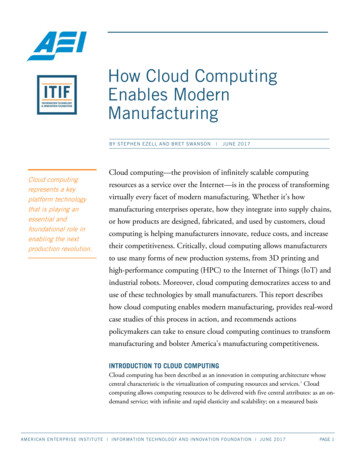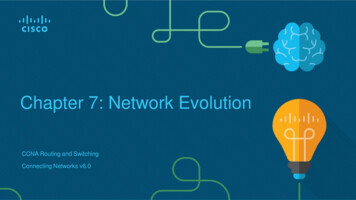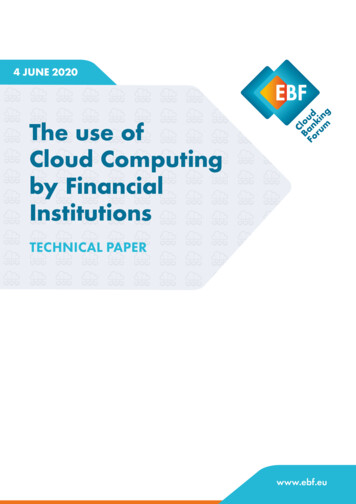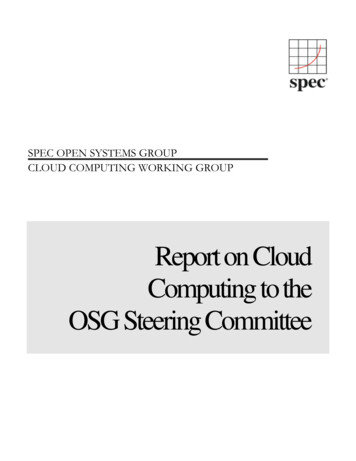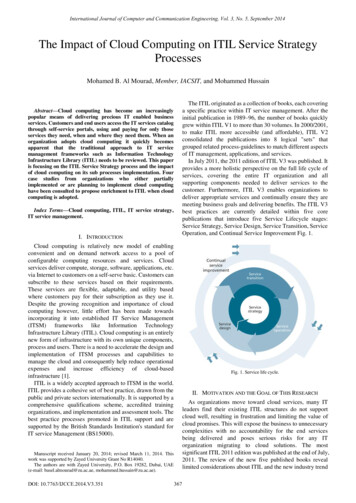
Transcription
International Journal of Computer and Communication Engineering, Vol. 3, No. 5, September 2014The Impact of Cloud Computing on ITIL Service StrategyProcessesMohamed B. Al Mourad, Member, IACSIT, and Mohammed Hussain The ITIL originated as a collection of books, each coveringa specific practice within IT service management. After theinitial publication in 1989–96, the number of books quicklygrew within ITIL V1 to more than 30 volumes. In 2000/2001,to make ITIL more accessible (and affordable), ITIL V2consolidated the publications into 8 logical "sets" thatgrouped related process-guidelines to match different aspectsof IT management, applications, and services.In July 2011, the 2011 edition of ITIL V3 was published. Itprovides a more holistic perspective on the full life cycle ofservices, covering the entire IT organization and allsupporting components needed to deliver services to thecustomer. Furthermore, ITIL V3 enables organizations todeliver appropriate services and continually ensure they aremeeting business goals and delivering benefits. The ITIL V3best practices are currently detailed within five corepublications that introduce five Service Lifecycle stages:Service Strategy, Service Design, Service Transition, ServiceOperation, and Continual Service Improvement Fig. 1.Abstract—Cloud computing has become an increasinglypopular means of delivering precious IT enabled businessservices. Customers and end users access the IT services catalogthrough self-service portals, using and paying for only thoseservices they need, when and where they need them. When anorganization adopts cloud computing it quickly becomesapparent that the traditional approach to IT servicemanagement frameworks such as Information TechnologyInfrastructure Library (ITIL) needs to be reviewed. This paperis focusing on the ITIL Service Strategy process and the impactof cloud computing on its sub processes implementation. Fourcase studies from organizations who either partiallyimplemented or are planning to implement cloud computinghave been consulted to propose enrichment to ITIL when cloudcomputing is adopted.Index Terms—Cloud computing, ITIL, IT service strategy,IT service management.I. INTRODUCTIONCloud computing is relatively new model of enablingconvenient and on demand network access to a pool ofconfigurable computing resources and services. Cloudservices deliver compute, storage, software, applications, etc.via Internet to customers on a self-serve basic. Customers cansubscribe to these services based on their requirements.These services are flexible, adaptable, and utility basedwhere customers pay for their subscription as they use it.Despite the growing recognition and importance of cloudcomputing however, little effort has been made towardsincorporating it into established IT Service Management(ITSM) frameworks like Information TechnologyInfrastructure Library (ITIL). Cloud computing is an entirelynew form of infrastructure with its own unique components,process and users. There is a need to accelerate the design andimplementation of ITSM processes and capabilities tomanage the cloud and consequently help reduce operationalexpenses and increase efficiency of cloud-basedinfrastructure [1].ITIL is a widely accepted approach to ITSM in the world.ITIL provides a cohesive set of best practice, drawn from thepublic and private sectors internationally. It is supported by acomprehensive qualifications scheme, accredited trainingorganizations, and implementation and assessment tools. Thebest practice processes promoted in ITIL support and aresupported by the British Standards Institution's standard forIT service Management (BS15000).Fig. 1. Service life cycle.II. MOTIVATION AND THE GOAL OF THIS RESEARCHAs organizations move toward cloud services, many ITleaders find their existing ITIL structures do not supportcloud well, resulting in frustration and limiting the value ofcloud promises. This will expose the business to unnecessarycomplexities with no accountability for the end servicesbeing delivered and poses serious risks for any ITorganization migrating to cloud solutions. The mostsignificant ITIL 2011 edition was published at the end of July,2011. The review of the new five published books reveallimited considerations about ITIL and the new industry trendManuscript received January 20, 2014; revised March 11, 2014. Thiswork was supported by Zayed University Grant No R14040.The authors are with Zayed University, P.O. Box 19282, Dubai, UAE(e-mail: basel.almourad@zu.ac.ae, mohammed.hussain@zu.ac.ae).DOI: 10.7763/IJCCE.2014.V3.351367
International Journal of Computer and Communication Engineering, Vol. 3, No. 5, September 2014of cloud computing. The majority of cloud-related contentcan be found in the ITIL Service Strategy book [2]. The bookintroduces the characteristics and attributes of cloud servicesand the various types of service delivery and deploymentmodels.Generally, empirical research in the IT servicemanagement domain is in its infancy [3], lacks scientificdiscussions [4] and has only just emerged [5]. Most of theresearch in this area is still focusing on ITIL implementationand best practices [6]-[8]. Interest in deploying IT servicemanagement tools in the cloud is great, and ITIL frameworkis applicable to manage cloud computing when adopted butthere are elements that need to be approached differently [9],[10]. This research argues that in order for ITIL to supportCloud computing, ITIL phases and associated processes mustbe carefully revamped and extend its capability so it canincorporate the cloud computing in the process of IT servicemanagement. For example, the cloud computing chargingmodel is based on consumption (pay as you go). The financialmanagement processes should be enhanced to consider thisnew model.Four different organizations that have either partiallyimplemented or about to implement cloud computing havebeen consulted. Successful adoption to cloud computingstarts with careful strategy processes planning followed bythe design, transition and operation. Because the scope of thisresearch is too big this paper only focuses on the impact ofcloud computing in the ITIL service strategy processes andwhat factors that must be considered when implementingITIL service process. Section III briefly explains the cloudcomputing, it’s service layers, and deployment model.Section IV defines ITIL service strategy and its mainprocesses. Section V represents the research methodology.Section VI discusses the findings of this research. Section VII,provides the conclusion of this research.III. WHAT IS CLOUD COMPUTING?Cloud computing is a model for enabling ubiquitous,convenient, on-demand network access to a shared pool ofconfigurable computing resources (e.g., networks, servers,storage, applications, and services) that can be rapidlyprovisioned and released with minimal management effort orservice provider interaction [11].Cloud computing represents a major shift in informationtechnology (IT) architecture, altering the way IT services aresourced and delivered. Software and information areprovided to computers and other devices on-demand, like apublic utility. Consumption is billed on a utility orsubscription basis with little or no upfront cost, creating a lowbarrier to entry. This new approach reduces upfront capitalexpenditures but there may be extra cost for operatingexpenses.A. Cloud Computing Service LayersCloud computing providers provide different kinds ofservices to cloud computing consumers. The cloudcomputing service model has three different service layers(See Fig. 2) or categories also known as the cloud stack [12].The cloud computing service layers are briefly explained inthe following:368Fig. 2. Cloud computing layers. Software as a Service (SaaS): is cloud computing layerwhere users simply make use of a web-browser toaccess software that others have developed, maintainand offer as a service over the web. At the SaaS level,users do not have control or access to the underlyingplatform and infrastructure that is being used to host thesoftware. Google Gmail is popular example that usesthe SaaS model of cloud computing [13]. Platform as a Service (PaaS) providers offer computingmiddleware. The consumers develop their applicationsand software using a set of programming languages andtools that are supported and provided by the PaaSprovider. PaaS provides developers with a high level ofabstraction that allows them to focus on developingtheir applications. Developers can provide theircustomers with a custom developed application withoutthe hassle of defining and maintaining the infrastructure.Just like the SaaS model, users do not have control oraccess to the underlying infrastructure being used tohost their applications at the PaaS level. Google AppEngine and Microsoft Azure are popular PaaS examples[14]. Infrastructure as a Service (IaaS) providers allow theircustomers access to different kinds of infrastructure (e.g.CPU power, memory and storage) and use the resourcesto deploy and run their applications through the use ofvirtual machines which automatically can scale up anddown. IaaS gives users flexibility to deploy anysoftware stack on top of the operating system. However,flexibility comes with a cost and users are responsiblefor updating and patching the operating system at theIaaS level. Amazon Web Services’ EC2 and S3 arepopular IaaS examples [15] Cloud computingdeployment modelsCloud computing has a number of differentimplementation models. An implementation model is aspecific method of providing a service. In the case of cloudcomputing these are unique methods of implementing a cloudcomputing service. Implementation models often haveparticular characteristics that suit them to appropriateworkloads. The most commonly used three-cloudimplementation models are: Private cloud: Created and run internally by anorganization or purchased and stored within theorganization and run by a third party Hybrid cloud: Outsources some but not all elementseither internally or externally Public cloud: No physical infrastructure locally, allaccess to data and applications is externalThe concerns for revamping ITIL service processes mainlyexist when the public or private cloud is hosted with third
International Journal of Computer and Communication Engineering, Vol. 3, No. 5, September 2014TABLE 1 ORGANIZATION CASE STUDIESCaseCaseCaseOrganizationsABCparty. When services of private cloud are hosted internallythere will be no substantial alteration in the way of using ITILframework.IV. ITIL SERVICE STRATEGY PROCESSService strategy is the central origin point of the ITILservice life cycle Fig. 1. The objective of ITIL servicestrategy is to provide guidance on how to design, develop andimplement service management [2]. It decides the strategy onhow to serve customers. Starting from an assessment ofcustomer needs and the market place, the Service Strategyprocess determines which services the IT organization is tooffer and what capabilities need to be developed. Its ultimategoal is to make the IT organization think and act in a strategicmanner. Simply the Service Strategy is a plane created by theIT Service Organization to reach its objectives. Thefollowing processes achieve ITIL service strategy:1) IT service management2) Service Portfolio Management3) Financial management for IT services4) Demand Management5) Business relationship managementThe cloud computing will not change ITIL service strategyobjectives, the above ITIL service strategy processes shouldbe revamped so it can adopt the new era of the cloudcomputing.CaseDNo of Staff700 10002500500No of IT staff600 2PPPLPLDonePartiallyDone--InternalBothBothBothITIL VersionCloud Computingadoption (Largely(L), Partially (P),Planning (PL), None(N))Stage of CloudImplementation (ifadopted)Reason for Cloudadoption (if any)Internal/External/Both/OtherVI. DISCUSSION AND FINDINGThe interview’s questionnaire outcome of the four casestudies were analyzed to identify patterns and summarize themain characteristics of approach and to select quotations thatare supportive of the patterns and themes identified across allcases[16]. The cross case analysis of the four organizationshas generated important cloud computing impacts that mustbe considered when implementing ITIL service strategyprocesses. The impacts of every process are detailed andillustrated with quotations from the ITIL personnel who hasbeen interviewed and questioned.V. RESEARCH METHODOLOGYA qualitative research using case studies is used to identifythe impact of Cloud computing on the ITIL service strategyprocess. We adopted qualitative method, as this research isexploratory in nature. The case study method provides theopportunity to ask penetrating questions and to capture theparticipant rich experiences and thoughts. A total of four casestudies reflecting four different organizations are carefullyselected and case semi-structured interviews with ITILpersonnel were conducted. The selected organizations fromUnited Arab Emirates (UAE) have either partly adoptedcloud computing or thinking to adopt it. Due to commercialsensitivity of the information and comments, the actualnames of the organizations can’t be disclosed. The four casesare referred to throughout the case discussion as case A-D.Table I introduces each organization in terms of size, nature,ITIL version, cloud computing adoption, stage of cloudcomputing implementation and reason of cloud computingimplementation. ITIL experts in these organizations wereinterviewed and questioned.Based on the main service strategy processes objectivesand literature review, we formulated some questions, whichare open in nature. The questionnaire contains three mainparts: Part A contains questions about the organization (i.e.size, nature, number of IT staff, etc.). Part B, containsquestions about the impact of the cloud computing on ITILservice strategy process. Part C gathers feedback about theconsideration of the service strategy processes when adoptingcloud computing. The questions are used as a guide throughthe interviews. However, we did not rely on these questionsonly, other emerged questions and ideas during the interviewwere also considered.A. IT Service ManagementThis process is introduced in ITIL 2011 edition. Also, thenew ITIL role Service Strategy Manager has been introducedto support the IT Steering Group. When adopting cloudcomputing the strategy management should assess the serviceprovider's offerings, capabilities, competitors as well ascurrent and potential market spaces in order to develop astrategy to serve customer needs.The IT service management must thoroughly research thecloud computing environment in order to address thefollowing concerns:Does the organization need to build its own infrastructure?IT Service Management must determine if the computinginfrastructure is expensive and too inflexible thus a highlyvirtualized cloud computing saves money.Which parts of the business will be moved to the cloud? ITService Management should consider the cloud for newapplications or business processes as requirements evolve.The cloud can significantly reduce time to market whenrolling out new functionality and processes.What type of cloud deployment should be used? Public,Private or Hybrid Clouds.How will information and data be secured? New measureswill be required to help ensure that while data can be accessedanywhere and anytime, businesses do not breach dataprotection laws.Once the strategy has been defined, the strategymanagement for IT services is also responsible for ensuringthe implementation of the strategy.369
International Journal of Computer and Communication Engineering, Vol. 3, No. 5, September 2014B. Service Portfolio ManagementThe purpose of a service portfolio is to describe a serviceprovider’s services in terms of the business value and needs.In order to assess the needs and requirements of the diversedepartments who wish to utilize and use certain cloudcomputing, the portfolio management should contain allnecessary information that are required to assess which cloudmodel is efficient to deploy and compare servicecompetitiveness & effectiveness across different providers. Itis essential that a portfolio be created for all potential externalcloud deployment models. Service Portfolio Managementprocess gathers as and analyzes the cloud service providerservices in the market and ensures that the service providerhas the right mix of services to meet the required businessoutcomes at an appropriate level of investment. The servicecatalogue must be regularly updated to reflect all live cloudcomputing services available.performance. This is an excellent feature from the demandmanagement’s point of view but the cloud consumers must bevery careful as the cloud service provider normally chargesany usage over the agreed levels at a premium rate. Thedemand management must carefully calculate demand toallocate the agreed budget within the financial managementprocess.When using the cloud, the performance requirements for acloud service must be accurately defined, especially withinthe peak period (low or high) and must be clearly articulatedin the Service Level Agreement (SLA). Failing to calculateand define the required performance is a source of risk andcould lead to obstruction or complete damage the consumerbusiness.C. Financial Management for IT ServicesThe main objective of the financial management process isto provide a cost effective administration of the assets andresources used in providing IT services. It manages theservice's budgeting, accounting and charging requirements.The aim of the financial management is to assistmanagement decision on IT investment by providing detailedcost analysis regarding changes to IT services.One of the key features of cloud computing is based on thefact that its charging is based on consumption (pay as you go).Financial management process must be changed toincorporate this fact when it peruses cost analysis calculation.The financial management process needs to provide thenecessary cost information in order to decide whether acertain service in the cloud can be deployed more efficientlyand able to save the costs over more traditional areas of IT.Consumer financial manager with the help of the service usermust collaborate to calculate the potential costs of a newcloud service to ensure they will indeed provide measurablecost saving. Since the cloud computing model charges on payas you go bases the financial management budgeting activitymust be changed to incorporate this model of charging.IT accounting and customers need information related tothe consumption bill and details about what and how thecloud service provider has billed them for. The IT accountingis fully responsible about explaining how is the money isspent by customer, service, etc. The cloud service providerneeds to have a well-defined and implemented billing processto satisfy the IT accounting and customer needs.D. Demand ManagementThe main objective of the demand management process isto understand, anticipate and influence business demand forservices. It does that by analyzing patterns of activities anduser profiles and provisioning capacity in line with strategicbusiness objectives Demand Management works withCapacity Management process in the Service Design serviceto ensure that services have sufficient capacity to meet therequired demand. One key promise of the cloud computing isthat any request for modification or deletion of the existingcapacity or resources has to be done in real time. Also, thecloud service provider must fulfill any sudden surge in theservice demand without compromising the agreedE. Business Relationship ManagementIn the traditional ITSM the Business RelationshipManagement process identifies the needs of existing andpotential customers and ensures that appropriate services aredeveloped to meet those needs.In the cloud environments, the purpose of the BusinessRelationship Management process is extended to form anduphold the cloud service provider and the customer businessrelationship. The Business Relationship Manager (BRM)identifies customer requirements and makes sure that thecloud service provider meets the requirements beforeagreeing to deliver the service. If business requirementschanges over time the BRM ensures that the service provideris aware of changing business needs and help the business inexpressing the value of a service. The objectives of the BRMinclude: Ensure that the cloud service provider understands thecustomer’s perspective of service, and is therefore ableto prioritize its services assets appropriately Guarantee that the cloud service provider is meeting thecustomer’s requirements and business needs otherwiseestablish formal complains and escalation process forthe customer Establish and maintain a constructive relationshipbetween the cloud service provider and the customerbased on understanding the customer and its businessdrivers Identify changes to the customer needs that couldpotentially impact the type, level, or utilization of thecloud services provided Establish and articulate business requirements for newservices or charges to existing ServicesVII. CONCLUSIONAdopting cloud computing is a serious business decision.IT service management frameworks such as ITIL is essentialand plays a critical role to manage the cloud computing.Although ITIL has been around for almost 20 years it must bereframed and consider the context of the cloud computing.The cloud computing will not change ITIL service strategyobjectives, the ITIL service strategy processes should berevamped on the light of the above discussion. Performingcareful service strategy will reduce the possibility ofexposing the business to unnecessary complexities with noaccountability for the end services being delivered and poses370
International Journal of Computer and Communication Engineering, Vol. 3, No. 5, September 2014[11] P. Mell and T. Grance, “The NIST definition of cloud computing(800-145),” National Institute of Standards and Technology, 2011.[12] S. Schuller. (2010). Cloud stack. [Online]. 2008/12/cloud stack.gif.[13] M. Armbrust, A. Fox, R. Griffith, A. Joseph, R. Katz, A. Konwinski etal., “Above the clouds: a berkeley view of cloud computing,” EECSDepartment, University of California, Berkeley, CA, 2009.[14] M. Boniface, B. Nasser, J. Papay, and S. Phillips et al., “Platformas-a-service architecture for real-time quality of service management incloud,” presented at Fifth International Conference on Internet andWeb Applications and Services, Barcelona. 2010.[15] M. Murphy, L. Abraham, M. Fenn, and S. Goasguen, “Autonomicclouds on the grid,” Journal of Grid Computing, vol. 8, issue 1, pp.1-18, 2009.[16] J. W. Creswell, Qualitative Inquiry and Research Design: ChoosingAmong Five Designs, CA: Sage., 1998.serious risks for any IT organization migrating to cloudsolutions.REFERENCESR. Sreekumar and P. Prabhakara, “ITIL for enterprise clouddeployment,” Infos Labs Briefings, vol. 9, no. 5, 2011.[2] D. Cannon, ITIL Service Strategy, The Stationery Office, 2011.[3] S. Conger, M. Winniford, and L. Erickson-Harris, “Servicemanagement in operations,” in Proc. American Conference onInformation Systems (AMCIS), 2008.[4] A. Hochstein, G. Tamm, and W. Brenner, “Service oriented ITmanagement: benefit, cost and success factors,” presented at TheEuropean Conference on Information Systems (ECIS), 2005.[5] J. Iden and L. Langeland, “Setting the stage for a successful ITILadoption: a delphi study of IT experts in the norwegian armed forces,”Information Systems Management, vol. 27, no. 2, pp. 103-112, 2010.[6] C. Pollard and A. Cater-Steel, “Justifications, strategies, and criticalsuccess factors in successful ITIL implementations in US andAustralian companies: an exploratory study,” Information SystemsManagement, vol. 26, pp. 164-175, 2009.[7] M. B. Almourad and R. Johari, “Resolution of challenges that arefacing organizations before ITIL implementation,” InternationalJournal of Future Computer and Communication, vol. 3, no. 3, pp.210-215, 2014.[8] M. Nicho and M. B. Almourad, “Success factors for integrated ITILdeployment: an IT governance classification,” Journal of InformationTechnology Case and Application Research, vol. 14, no. 1, p. 25, 2012.[9] M. Jansen, “Will cloud computing change standards in IT servicemanagement?” International Journal of Computers AndCommunications, vol. 1, no. 6, 2012.[10] IBM Global Technology, Integrated Service Management and CloudComputing: More than Just Technology Best Friends, White Paper,IBM Global Technology Services, 2010.[1]M. B. Al Mourad has received his B.Sc in informaticsengineering from Aleppo University, Syria, and hisPh.D degree in computer science from CardiffUniversity of Wales, United Kingdom. He has servedin various international universities. He is currently anassistant professor in Zayed University, Dubai, UAE.Dr. Al-Mourad is active in several research areaswhere he published numerous articles including: ITservicemanagement,heterogeneousdatamanagement, semantic web, web accessibility and community of practice.M. Hussain is an assistant professor at the University College, ZayedUniversity, UAE. He earned his M.Sc. and Ph.D. from the School ofComputing at Queen’s University, Canada. His main research interests arenetwork security, user privacy and cloud computing.371
following processes achieve ITIL service strategy: 1) IT service management . 2) Service Portfolio Management . 3) Financial management for IT services . 4) Demand Management . 5) Business relationship management . The cloud computing will not change ITIL service strategy objectives, the above ITIL service strategy processes should





